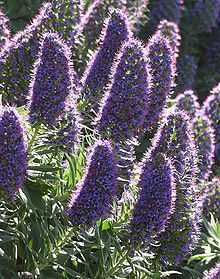Madeira
| Madeira | |||
| Autonomous Region (Região Autónoma) | |||
 A view of Funchal, the capital city of the autonomous region. | |||
|
|||
| Official name: Região Autónoma da Madeira | |||
| Name origin: madeira, Portuguese for wood | |||
| Motto: Das ilhas, as mais belas e livres (Of all islands, the most beautiful and free) | |||
| Nickname: Pérola do Atlântico (Pearl of the Atlantic) | |||
| Country | |||
|---|---|---|---|
| Autonomous Region | |||
| Region | Atlantic Ocean | ||
| Subregion | Tore-Madeira Ridge | ||
| Position | Madeira Platform, Savage Islands submarine mount | ||
| Islands | Madeira, Porto Santo, Desertas, Selvagens | ||
| Municipalities | Calheta, Câmara de Lobos, Funchal, Machico, Ponta do Sol, Porto Moniz, Porto Santo, Ribeira Brava, Santa Cruz, Santana, São Vicente | ||
| Capital | Funchal | ||
| Largest city | Funchal | ||
| - coordinates | 32°39′4″N 16°54′35″W / 32.65111°N 16.90972°W | ||
| Highest point | Pico Ruivo | ||
| - location | Paul da Serra, Santana, Madeira | ||
| - elevation | 1,862 m (6,109 ft) | ||
| Lowest point | Sea level | ||
| - location | Atlantic Ocean, Madeira | ||
| - elevation | 0 m (0 ft) | ||
| Area | 801 km2 (309 sq mi) | ||
| Population | 267,785 (2011) Estimate[1] | ||
| Density | 308.5 / km2 (799 / sq mi) | ||
| Settlement | c. 1420 | ||
| - Administrative autonomy | c. 1895 | ||
| - Political autonomy | 4 September 1976 | ||
| Discovery | c. 1415 | ||
| Management | |||
| - location | Assembleia Regional, Sé, Funchal | ||
| - elevation | 16 m (52 ft) | ||
| - coordinates | 32°38′49.96″N 16°54′29.59″W / 32.6472111°N 16.9082194°W | ||
| Government | |||
| - location | Quinta Vigia, Sé, Funchal | ||
| - elevation | 51 m (167 ft) | ||
| - coordinates | 32°38′42.39″N 16°54′57.16″W / 32.6451083°N 16.9158778°W | ||
| President (Government) | Alberto João Jardim (PPD-PSD) | ||
| - President (Assembleia) | José Miguel Jardim d´Olival de Mendonça (PPD-PSD) | ||
| Timezone | WET (UTC+0) | ||
| - summer (DST) | WEST (UTC+1) | ||
| ISO 3166-2 code | PT-30 | ||
| Postal code | 9XXX-XXX | ||
| Area code | (+351) 291 XXX XXX | ||
| ccTLD | .pt | ||
| Date format | dd-mm-yyyy | ||
| Drive | right-side | ||
| Demonym | Madeiran; Madeirense | ||
| Patron Saint | Nossa Senhora do Monte | ||
| Holiday | 1 July | ||
| Anthem | A Portuguesa (national) Hino da Madeira (regional) | ||
| Currency | Euro (€)[2] | ||
| Gross domestic product (PPP) | € 6,361 billion[3] | ||
| Per capita GDP | € 25,800-$35,589[3] | ||
 Location of Madeira relative to Portugal (green) and the rest of the European Union (light green)
| |||
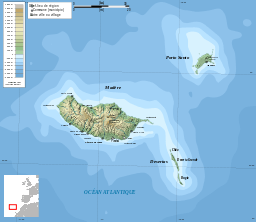 Distribution of the islands of the archipelago (not including the Savage islands)
| |||
| Wikimedia Commons: Madeira | |||
| Statistics: Instituto Nacional de Estatística[4] | |||
| Website: www.gov-madeira.pt | |||
| Geographic detail from CAOP (2010)[5] produced by Instituto Geográfico Português (IGP) | |||
Madeira (/məˈdɪərə/ mə-DEER-ə or /məˈdɛərə/ mə-DAIR-ə; Portuguese: [mɐˈðejɾɐ] or [mɐˈðɐjɾɐ]) is a Portuguese archipelago that lies between 32°22.3′N 16°16.5′W / 32.3717°N 16.2750°W and 33°7.8′N 17°16.65′W / 33.1300°N 17.27750°W, just under 400 kilometres (250 mi) north of Tenerife, Canary Islands, in the north Atlantic Ocean and an outermost region of the European Union.[6] The archipelago comprises the major part of one of the two Autonomous regions of Portugal (the other being the Azores located to the northwest), that includes the islands of Madeira, Porto Santo, and the Desertas, administered together with the separate archipelago of the Savage Islands.
Madeira was claimed by Portuguese sailors in the service of Infante D. Henrique (Henry the Navigator) in 1419, and settled after 1420. The archipelago is considered to be the first territorial discovery of the exploratory period of the Portuguese Age of Discovery.
Today, it is a popular year-round resort, being visited every year by about one million tourists,[7] noted for its Madeira wine, flowers, landscapes and embroidery artisans, as well as for its annual New Year celebrations that feature the largest fireworks show in the world, as officially recognised by the Guinness World Records, in 2006.[8][9] The main harbour in Funchal is the leading Portuguese port in cruise liner dockings,[10] being an important stopover for commercial and trans-Atlantic passenger cruises between Europe, the Caribbean and North Africa.
Madeira is currently the second richest region in Portugal, after Lisbon, with a GDP per capita of 104% of the European average.[11]
History
Exploration
Pliny mentioned certain "Purple Islands", their position corresponding to the location of the Fortunate Isles (or Canary Islands), that may have referred to islands of Madeira. Plutarch (Sertorius, 75 AD) referring to the military commander Quintus Sertorius (d. 72 BC), relates that after his return to Cádiz: "...The islands are said to be two in number separated by a very narrow strait and lie 10,000 furlongs from Africa. They are called the Isles of the Blessed..." The estimated distance from Africa, 2,000 kilometres (1,200 mi), and the closeness of the two islands, seem to describe the similar position of the islands of Madeira and Porto Santo.
Legend
There is also a romantic tale of two lovers, Robert Machim and Anna d'Arfet, during the reign of King Edward III of England, who, fleeing from England to France in 1346, were driven off their course by a violent storm. Their ship crashed along the coast of an island, that may have been Madeira; later, this story would be used in the naming of Machico, whose name was transliterated from the name of the boy in the tale, in memory of the young lovers.[12]
Discovery
Much like the Azores, it is clear that some knowledge of Atlantic islands, such as Madeira, existed before the discovery and settlement of these lands, as the islands appear on maps as early as 1339.[13] From a portolan dating to 1351, and preserved in Florence, Italy, it would appear that the islands of Madeira had been discovered long before Portuguese vessels rediscovered them. In Libro del Conocimiento (1348–1349), a Castilian monk also identified the location of the islands in its present location, with the names Leiname (modern Italian legname, cognate of Portuguese madeira, "wood"), Diserta and Puerto Santo.

13.jpg)

Officially, in 1418, two captains under service to Prince Henry the Navigator, João Gonçalves Zarco and Tristão Vaz Teixeira, were driven off-course by a storm to an island which they named Porto Santo (English: holy harbour); the name was bestowed for their gratitude and divine deliverance from a possible shipwreck by the protected anchorage. The following year, an organised expedition, under the captaincy of Zarco and Vaz Teixeira, was sent to this new land, and along with captain Bartolomeu Perestrello, to take possession of the island on behalf of the Portuguese crown. Subsequently, the new settlers observed "a heavy black cloud suspended to the southwest",[14] which when investigated led to the discovery of the larger island of Madeira.[15]
Settlement
The first settlers began colonizing the islands around 1420 or 1425; the three Captains-major had led the first settlement, along with their respective families, a small group of minor nobility, people of modest conditions and some prisoners, who could be trusted to work the lands. To gain the minimum conditions for the development of agriculture, they had to rough-hew a part of the dense forest of laurisilva and to construct a large number of canals (levadas), since in some parts of the island there was excess water, while in others water was scarce. During this period, fish constituted about half of the settlers' diet, together with vegetables and fruits cultivated from small cleared parcels of land. Initially, these colonists produced wheat for their own subsistence, but later the quantity cultivated was sufficient to begin exporting wheat to continental Portugal.
On the 23 September of 1433, the name Ilha da Madeira (English: Madeira Island, or literally island of wood) began to appear in the first documents and maps. The name given to the islands corresponded to the large dense forests of native laurisilva trees that populated the island during the settlement.
However, when grain production began to fall, the ensuing crisis forced Henry the Navigator, as principal benefactor of the islands, to plant other commercial crops. The planting of sugarcane, and later Sicilian sugar beet, allowed the introduction of the "sweet salt" (as sugar was known) into Europe, where it was a rare and popular spice. These specialised plants, and their associated industrial technology, created one of the major revolutions on the islands and fuelled Portuguese industry. The expansion of sugar plantations in Madeira began in 1455, using advisers from Sicily and financed by Genoese capital (it would become an integral part of the island economy until the 17th century). The accessibility of Madeira attracted Genoese and Flemish traders who were keen to bypass Venetian monopolies.
- "By 1480 Antwerp had some seventy ships engaged in the Madeira sugar trade, with the refining and distribution concentrated in Antwerp. By the 1490s Madeira had overtaken Cyprus as a producer of sugar."[16]
Sugarcane production was the primary engine of the island's economy, increasing the demand for labour. Slaves were used during portions of the island's history to cultivate sugar cane, and the proportion of imported slaves reached 10% of the total population of Madeira by the 16th century.[17]
In 1617, Algerian pirates, having enslaved Europeans along the Mediterranean coasts, captured 1,200 men and women in Porto Santo.[18][19] After the 17th century, as sugar production shifted to Brazil, São Tomé and Príncipe and elsewhere, Madeira's most important product became its wine. The British occupied Madeira as a result of the Napoleonic Wars, a consented occupation starting in 1807 and concluding in 1814 when the island was returned to Portugal.[20] Nevertheless, the island was a British Crown Colony for four months, and Britain had intentions of keeping it after the Napoleonic Wars, owing to its strategic position, but plans for its permanent annexation were abandoned shortly after the start of the occupation.[21]
When, after the death of King John VI of Portugal, his usurper son Miguel of Portugal seized power from the rightful heir, his niece Maria II, and proclaimed himself 'Absolute King', Madeira held out for the queen under the governor José Travassos Valdez until Miguel sent an expeditionary force and the defence of the island was overwhelmed by crushing force. Valdez was forced to flee to England under the protection of the Royal Navy (September 1828).
World War I
The effect on Portugal in World War I was first felt in Madeira on December 31, 1916 when the German U-boat, SM U-38, captained by Max Valentiner went into Funchal harbour on Madeira and torpedoed and sank 8 ships, CS Dacia (1,856 tons),[22] SS Kanguroo (2,493 tons)[23] and Surprise (680 tons).[24] The commander of the French gunboat Surprise and 34 of her crew (7 Portuguese) died in the attack. The Dacia, a British cable laying vessel,[25] had previously undertaken war work off the coast of Casablanca and Dakar, was in the process of diverting the German South American cable into Brest, France. Following the attack on the ships, the Germans proceeded to bombard Funchal for two hours from a range of about 2 miles (3 km). Batteries on Madeira returned fire and eventually forced the Germans to withdraw.
On 12 December 1917, 2 German U-boats, SM U-156 and SM U-157 (captained by Max Valentiner) again bombarded Funchal, Madeira. This time the attack lasted around 30 minutes. Forty, 4.7-inch (120 mm) and 5.9-inch (150 mm) shells were fired. There were 3 fatalities and 17 wounded, In addition, a number of houses and Santa Clara church were hit.
The last Emperor of the Austro-Hungarian Empire, Charles I (Blessed Charles of Austria), went into exile in Madeira, after his second unsuccessful coup d'état in Hungary. He died there on April 1, 1922 and is buried in Monte. Charles had tried in 1917 to secretly enter into peace negotiations with France. Although his foreign minister, Ottokar Czernin, was only interested in negotiating a general peace which would include Germany as well, Charles himself, in negotiations with the French with his brother-in-law, Prince Sixtus of Bourbon-Parma, an officer in the Belgian Army, as intermediary, went much further in suggesting his willingness to make a separate peace. When news of the overture leaked in April 1918, Charles denied involvement until the French Prime Minister Georges Clemenceau published letters signed by him. This led to Czernin's resignation, forcing Austria-Hungary into an even more dependent position with respect to its seemingly wronged German ally. Determined to prevent a restoration attempt, the Council of Allied Powers had agreed on Madeira because it was isolated in the Atlantic and easily guarded.[26]
Autonomy
On 1 July 1976, following the democratic revolution of 1974, Portugal granted political autonomy to Madeira, celebrated on Madeira Day. The region now has its own government and legislative assembly.
Geography
Physical geography
| Madeira | |
| Island (Ilha) | |
 A three-dimensional rendering of topographic maps characterizing the island of Madeira | |
| Official name: Ilha da Madeira | |
| Name origin: madeira, Portuguese for the wood | |
| Country | |
|---|---|
| Autonomous Region | |
| Location | Tore-Madeira Ridge, African Tectonic Plate, Atlantic Ocean |
| Archipelago | Madeira |
| Municipalities | Calheta, Câmara de Lobos, Funchal, Machico, Ponta do Sol, Porto Moniz, Ribeira Brava, Santa Cruz, Santana, São Vicente |
| Highest point | Pico Ruivo |
| - location | Pico Ruivo, [(Santana)], Santana |
| - elevation | 1,862 m (6,109 ft) |
| Lowest point | Sea level |
| - location | Atlantic Ocean |
| - elevation | 0 m (0 ft) |
| Length | 57 km (35 mi), West-East |
| Width | 22 km (14 mi), North-South |
| Area | 740.7 km2 (286 sq mi) |
| Biomes | Temperate, Mediterranean |
| Geology | Alkali basalt, Tephra, Trachyte, Trachybasalt |
| Orogeny | Volcanism |
| Period | Miocene |
| Demonym | Madeirense; Madeiran |
| Ethnic groups | Portuguese |
| Wikimedia Commons: Madeira | |
| Website: http://www.gov-madeira.pt | |
| Statistics from INE (2001); geographic detail from Instituto Geográfico Português (2010) | |

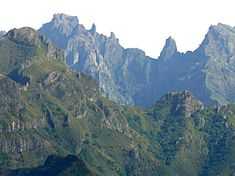

.jpg)

The archipelago of Madeira is located 520 km (323.11 mi) from the African coast and 1,000 km (621.37 mi) from the European continent (approximately a one-and-a-half hour flight from the Portuguese capital of Lisbon).[27] It is found in the extreme south of the Tore-Madeira Ridge, a bathymetric structure of great dimensions oriented along a north-northeast to south-southwest axis that extends for 1,000 kilometres (620 mi). This submarine structure consists of long geomorphological relief that extends from the abyssal plain to 3500 metres; its highest submersed point is at a depth of about 150 metres (around latitude 36ºN). The origins of the Tore-Madeira Ridge are not clearly established, but may have resulted from a morphological buckling of the lithosphere.[28][29]
The archipelago itself is a series of oceanic volcanic islands that date back to the Miocene (about 20 million years ago), and constructed from a hotspot in the Earth's crust of the African Tectonic Plate. Madeira, and the smaller Desertas Islands, are the youngest of these islands (dating from 4.6 to 0.7 million years), while Porto Santo, the smaller of the main islands, is the oldest (approximately 14 million years). Since their immersion, there have been five phases related to the volcanism of the group, and they are particularly visible on the island of Madeira, which include:
Base formation - characterised by large eruptions and ejecta which terminated about three million years ago; Peripheral formation - where there is a diminishing level of the projectiles, causing the formation of several dykes and platforms, that terminated about 740,000 years ago; High altitude formation - marked by a continuation of projectiles, pyroclastic materials and the formation of faults along the northern and southern coasts (between 400–900 meters); Paul da Serra - formation that travelled along the Bica da Cana around 550,000 years ago; Recent eruptions, associated with minor island formations; the magma fields discovered on the islands (which terminated about 6500 years ago) are associated with this phase.
These basaltic islands have not seen any volcanic activity within the last 6000 years.
Islands and islets
Madeira (740.7 km²), including Ilhéu de Agostinho, Ilhéu de São Lourenço, Ilhéu Mole (northwest);
Porto Santo (42.5 km²), including Ilhéu de Baixo ou da Cal, Ilhéu de Ferro, Ilhéu das Cenouras, Ilhéu de Fora, Ilhéu de Cima;
Desertas Islands (14.2 km²), including the three uninhabited islands: Deserta Grande Island, Bugio Island and Ilhéu de Chão;
Savage Islands (3.6 km²), archipelago 280 km south-southeast of Madeira Island including three main islands and 16 uninhabited islets in two groups: the Northwest Group (Selvagem Grande Island, Ilhéu de Palheiro da Terra, Ilhéu de Palheiro do Mar) and the Southeast Group (Selvagem Pequena Island, Ilhéu Grande, Ilhéu Sul, Ilhéu Pequeno, Ilhéu Fora, Ilhéu Alto, Ilhéu Comprido, Ilhéu Redondo, Ilhéu Norte).
Madeira Island
The island of Madeira is at the top of a massive shield volcano that rises about 6 km (3.7 mi) from the floor of the Atlantic Ocean, on the Tore underwater mountain range. The volcano formed atop an east-west rift[30][31] in the oceanic crust along the African Plate, beginning during the Miocene epoch over 5 million years ago, continuing into the Pleistocene until about 700,000 years ago.[32] This was followed by extensive erosion, producing two large amphitheatres open to south in the central part of the island. Volcanic activity later resumed, producing scoria cones and lava flows atop the older eroded shield. The most recent volcanic eruptions were on the west-central part of the island only 6,500 years ago, creating more cinder cones and lava flows.[32]
Madeira Island represents 93% of the archipelago's area, with 90% of the landmass above 500 m. It is the largest island of the group with an area of 741 km2 (286 sq mi), a length of 57 km (35 mi) (from Ponte de São Lourenço to Ponte do Pargo), while approximately 22 km (14 mi) at its widest point (from Ponte da Cruz to Ponte São Jorge), with a coastline of 150 km (93.21 mi). It has a mountain ridge that extends along the centre of the island, reaching 1862 meters (6,107 ft) at its highest point (Pico Ruivo), while much lower (below 200 meters) along its eastern extent. The primitive volcanic foci responsible for the central mountainous area, consisted of the peaks: Ruivo (1862 meter), Torres (1851 meter), Areeiro (1818 meter), Cidrão (1802 meter), Cedro (1759 meter), Casado (1725 meter), Grande (1657 meter), Ferreiro (1582 meter). At the end of this eruptive phase, an island circled by reefs was formed, its marine vestiges are evident in a calcareous layer in the area of Lameiros, in São Vicente (which was later explored for calcium oxide production). Sea cliffs, such as Cabo Girão, valleys and ravines extend from this central spine, making the interior generally inaccessible.[33] Daily life has concentrated in the many villages at the mouths of the ravines, through which the heavy rains of autumn and winter usually travel to the sea.[34] A long, narrow, and comparatively low rocky promontory forms (Paul da Serra) the western extremity of the island, on which lies a tract of calcareous sand known (1300-1500 meter). It is a fossil bed, that contains shells and numerous bodies resembling the roots of trees, probably produced by infiltration.
The island was formed from a base volcanic complex, forming to two massifs:
- The Base Volcanic Complex was formed during the Miocene period from submarine and sub-aerial eruptions in the central part of the island, and is associated with some of the deeper valleys (São Vicente, Boaventura, Socorridos). The complex extends to the east into the (Porto da Cruz and Machico) ravines until Ponta de São Lourenço and consists of accumulated block pyroclasts, lapilli and ash, layered with basaltic lava. The volcanic material is essentially effusive, of non-viscous compact basalts; the lava formed flows that were not dense which covered the topography and substrata. These first flows were extensive, occupying a large part of the plateau, filling many of the valleys and ending at the sea. More recent episodes were confined into the valley of the São Vicente, Seixal and Porto Moniz ravines. The basaltic flows correspond to the last period of volcanic activity on Madeira (around 500,000-200,000 of years). The flows were boxed into the valleys, and fossilised, sometimes, such as in the valley of São Vicente, forming morphological terraces. The island is covered in faults, and easily identifiable in the area around Ribeira Brava, near Encumeada. The spatial distribution of these faults is varied and their align is also diverse, although it is common to encounter some faults from west-northwest to east-south-southeast to northwest to southeast (coincident with the direction of some volcanic cones). Between many of pyroclastic cliffs, there exists a great variability in materials, from large blocks to fine ash, and an intermediary layer referred to locally as feijoco, or lapilli, of a consistency that is more porous. The material is normally dark to black rocks, yellow and reddish materials, and is used in some construction for their refractive characteristics (as well as used in the construction of blast ovens).
- The Central Massif which occupies the central region of the island, consists of explosive material (large blocks, lapilli and ash) and deposited chaotically around volcanic centres of the eruptions, but today mostly hidden and unrecognisable. This massif is crossed by several dense faults, basaltic and trachyte, oriented in many directions, converging on Pico Ruivo. The peak which includes many dykes, has resisted erosion, in contrast to many of the surrounding deposits; the weak cohesion of pyroclastic materials permitted the easy carving of the terrain in this area, constituting the morphology of many of the ravines: Brava, Socorridos, Machico, São Vicente, Porco (Boaventura) and Faial.
- The Paul da Serra Massif corresponds to a similar structural platform of basaltic flows oriented towards the southwest.
Climate
Madeira has been classified as a Mediterranean climate (Köppen climate classification: Csa/Csb),[35] but based on differences in sun exposure, humidity, and annual mean temperature there are clear variations between north- and south-facing regions, as well as between some islands. Other microclimates are expected to exist, from the constantly humid wettest points of the mountains, to the desert and arid Selvagens islands. The islands are strongly influenced by the Gulf Stream and Canary Current, giving mild year-round temperatures; according to the Instituto de Meteorologia or IM the average annual temperature at Funchal weather station is 19.6 °C (67.3 °F) for the 1980–2010 period. For the 1960-1990 period, IM published an article, showing that some regions in the South Coastline surpass 20 °C (68 °F) in annual average. Porto Santo has at least one weather station with a semiarid climate (BSh).
| Climate data for Funchal, capital of Madeira | |||||||||||||
|---|---|---|---|---|---|---|---|---|---|---|---|---|---|
| Month | Jan | Feb | Mar | Apr | May | Jun | Jul | Aug | Sep | Oct | Nov | Dec | Year |
| Average high °C (°F) | 19.1 (66.4) |
19.1 (66.4) |
19.5 (67.1) |
19.6 (67.3) |
20.9 (69.6) |
22.3 (72.1) |
24.3 (75.7) |
25.6 (78.1) |
25.7 (78.3) |
24.2 (75.6) |
22.0 (71.6) |
20.0 (68) |
21.8 (71.2) |
| Daily mean °C (°F) | 16.1 (61) |
16.0 (60.8) |
16.3 (61.3) |
16.5 (61.7) |
17.8 (64) |
19.4 (66.9) |
21.2 (70.2) |
22.3 (72.1) |
22.3 (72.1) |
20.9 (69.6) |
18.8 (65.8) |
17.0 (62.6) |
18.6 (65.5) |
| Average low °C (°F) | 13.1 (55.6) |
12.8 (55) |
13.0 (55.4) |
13.4 (56.1) |
14.6 (58.3) |
16.5 (61.7) |
18.0 (64.4) |
18.9 (66) |
18.9 (66) |
17.6 (63.7) |
15.6 (60.1) |
13.9 (57) |
15.5 (59.9) |
| Rainfall mm (inches) | 102.7 (4.043) |
87.2 (3.433) |
63.6 (2.504) |
38.9 (1.531) |
18.9 (0.744) |
11.9 (0.469) |
25 (0.98) |
31 (1.22) |
36.7 (1.445) |
75.0 (2.953) |
100.8 (3.969) |
99.9 (3.933) |
691.6 (27.224) |
| Avg. rainy days (≥ 0.1 mm) | 12 | 11 | 10 | 8 | 5 | 3 | 1 | 2 | 6 | 9 | 11 | 13 | 91 |
| Mean monthly sunshine hours | 167.4 | 171.1 | 204.6 | 225.0 | 213.9 | 198.0 | 244.9 | 260.4 | 225.0 | 204.6 | 168.0 | 164.3 | 2,447.2 |
| Source: World Meteorological Organization (UN),[36] Climatetemp.info[37] for Sunshine hours data | |||||||||||||
Wildfires

Drought conditions coupled with hot and windy weather in summer have caused numerous wildfires in recent years. The largest of the fires in August, 2010 burned through 95 percent of the Funchal Ecological Park, a 1,000-hectare preserve set aside to restore native vegetation to the island.[38][39] In July, 2012 Madeira was suffering from severe drought and wildfires began burning on July 18, in the midst of temperatures up to 40 degrees Celsius (more than 100 degrees Fahrenheit) and high winds. By July 20, fires had spread to the nearby island of Porto Santo, and firefighters were sent from mainland Portugal to contain the multiple blazes.[40][41][42][43]
In August, 2013 a hospital and some homes were evacuated as a wildfire approached Funchal. A number of homes were destroyed when the fire hit Monte, a suburb of Funchal.[44][45]
Biome

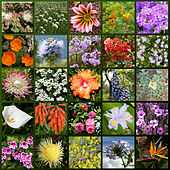

The Macaronesia region harbours an important floral diversity. In fact, the archipelago's forest composition and maturity are quite similar to the forests found in the Tertiary period that covered Southern Europe and Northern Africa millions of years ago. The great biodiversity of Madeira is phytogeographically linked to the Mediterranean region, Africa, America and Australia, and interest in this phytogeography has been increasing in recent years due to the discovery of some epiphytic bryophyte species with non-adjacent distribution.
Madeira also has many endemic species of fauna – mostly invertebrates which include the extremely rare Madeiran Large White but also some vertebrates such as the native bat, some lizards species, and some birds as already mentioned. The biggest tarantula of Europe is found on Desertas islands of Madeira and can be as wide as a man's hand. These islands have more than 250 species of land molluscs (snails and slugs), some with very unusual shell shape and colours, most of which are endemic and vulnerable.
Madeira has three endemic bird species: Zino's Petrel, the Trocaz Pigeon and the Madeira Firecrest, while the Madeiran Chaffinch is an endemic subspecies. It is also important for breeding seabirds, including the Madeiran Storm-petrel, North Atlantic Little Shearwater and Cory's Shearwater.
Native birds gallery
In the south, there is very little left of the indigenous subtropical rainforest which once covered the whole island (the original settlers set fire to the island to clear the land for farming) and gave it the name it now bears (Madeira means "wood" in Portuguese). However, in the north, the valleys contain native trees of fine growth. These "laurisilva" forests, called lauraceas madeirense, notably the forests on the northern slopes of Madeira Island, are designated as a World Heritage Site by UNESCO. The critically endangered vine Jasminum azoricum is one of the plant species that is endemic to Madeira.[46]
Native flora gallery
Levadas
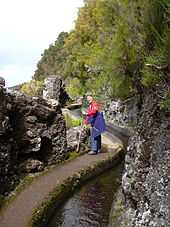
The island of Madeira is wet in the northwest but dry in the southeast. In the 16th century the Portuguese started building levadas or aqueducts to carry water to the agricultural regions in the south. The most recent were built in the 1940s. Madeira is very mountainous, and building the levadas was difficult and often sentenced criminals or slaves were used. Many are cut into the sides of mountains, and it was also necessary to dig 25 miles (40 km) of tunnels, some of which are still accessible.
Today the levadas not only supply water to the southern parts of the island but provide hydro-electric power. There are over 1,350 miles (2,170 km) of levadas and they provide a remarkable network of walking paths. Some provide easy and relaxing walks through beautiful countryside, but others are narrow, crumbling ledges where a slip could result in serious injury or death.
Two of the most popular levadas to hike are the Levada do Caldeirão Verde and the Levada do Caldeirão do Inferno which should not be attempted by hikers prone to vertigo or without torches and helmets. The Levada do Caniçal is a much easier walk, running 7.1 miles (11.4 km) from Maroços to the Caniçal Tunnel. It is known as the mimosa levada because mimosa trees are found all along the route.
Political divisions




Administratively, Madeira (with a population of 267,302 inhabitants in 2011[4]) and covering an area of 768.0 km2 (296.5 sq mi) is organised into eleven municipalities:[47]
| Municipality | Population (2011)[4] | Area | Main settlement | Parishes |
| Funchal[48] | 111,892 | 75.7 km2 (29.2 sq mi) | Funchal | 10 |
| Santa Cruz[49] | 43,005 | 68.0 km2 (26.3 sq mi) | Santa Cruz | 5 |
| Câmara de Lobos | 35,666 | 52.6 km2 (20.3 sq mi) | Câmara de Lobos | 5 |
| Machico | 21,828 | 67.6 km2 (26.1 sq mi) | Machico | 5 |
| Ribeira Brava | 13,375 | 64.9 km2 (25.1 sq mi) | Ribeira Brava | 4 |
| Calheta | 11,521 | 110.3 km2 (42.6 sq mi) | Calheta | 8 |
| Ponta do Sol | 8,862 | 46.8 km2 (18.1 sq mi) | Ponta do Sol | 3 |
| Santana | 7,719 | 93.1 km2 (35.9 sq mi) | Santana | 6 |
| São Vicente | 5,723 | 80.8 km2 (31.2 sq mi) | São Vicente | 3 |
| Porto Santo[50] | 5,483 | 42.4 km2 (16.4 sq mi) | Vila Baleira | 1 |
| Porto Moniz | 2,711 | 82.6 km2 (31.9 sq mi) | Porto Moniz | 4 |
Funchal
Funchal is the capital and principal city of the Madeira Autonomous Region, located along the southern coast of the island of Madeira. It is a modern city, located within a natural geological "amphitheatre" composed of vulcanological structure and fluvial hydrological forces. Beginning at the harbour (Porto de Funchal), the neighbourhoods and streets rise almost 1,200 metres (3,900 ft), along gentle slopes that helped to provide a natural shelter to the early settlers.
With five centuries of populated history, Funchal was named by the early discoverers and settlers, for the abundance of fennel (funcho) that was found in this heavily forested area. The natural harbour and climate, combined with an excellent geographical position, allowed Funchal to rapidly grow. Its Sé Cathedral, built between 1493 and 1514 (by Pêro Annes in Manueline-style), was one of the main centres of activity during its formative period, and represents one of Madeira's numerous historical treasures.
Population
Demographics
When the Portuguese discovered the island of Madeira in 1419, it was uninhabited by humans, with no aboriginal population. The island was settled by Portuguese people, especially farmers from the Minho region,[51] meaning that Madeirans (Portuguese: Madeirenses), as they are called, are ethnically Portuguese, though they have developed their own distinct regional identity and cultural traits.
The region has a total population of just under 270,000, the majority of whom live on the main island of Madeira where the population density is 337/km²; meanwhile only around 5,000 live on the Porto Santo Island where the population density is 112/km².
Population genetics
As in continental Portugal, the most frequent mtDNA haplogroup in Madeira is H (36.2%), followed by U (19.4% including 3.9% of North African Berber U6), T (7.7%), pre-HVclades (7.1%) and K (6.5%). Two haplogroups, H and U5 alone account for more than 50% of the individuals. The relatively high frequency of sub-Saharan L and M1 haplogroups (14.8%) in Madeira is also consistent with the historical records of slaves being introduced in both the south of Portugal and in Madeira.[52]
| Sample | H | I | J | K | T | U (except U6) | Pre-V | W | X | U6 | M1 | L1 | L2 | L3 |
| 155 | 36.2 | 1.3 | 2.6 | 6.5 | 7.7 | 15.5 | 7.1 | 1.9 | 0.6 | 3.9 | 1.9 | 4.5 | 2.6 | 5.8 |
Concerning the males Y-Dna haplogroups, R1b (particularly R1b3) was found to be the most dominant Y chromosomal lineage in Madeira, covering about 53% of the Y chromosomal lineages. The high frequency of this haplogroup is typical in all West European populations, reflecting a cline and likely continuity of the Palaeolithic gene pool in Europe. Haplogroups I and G, also characteristic markers for many different West European populations, were found in Madeira at frequencies above 5%. Together with R1b, haplogroups J (12%) and E1b1b (14%) comprise about 80% of the Y-chromosomal gene pool of Madeira individuals. Haplogroups J and E1b1b consist of lineages with differential distribution within Middle East, North Africa and Europe. The typical Berber haplogroup E1b1b1b (M81) was found as in continental Portugal at a frequency of 5–6%.[53]
| Sample | A | E1b1b1 | E1b1b1a | E1b1b1b | E1b1b1c | G | I | J* | J2 | T | L | N1c | R1* | R1a | R1b |
| 129 | 0.8 | 1.6 | 5.4 | 5.4 | 1.6 | 3.1 | 7.0 | 0.8 | 10.9 | 3.1 | 1.6 | 2.3 | 1.6 | 2.3 | 52.7 |
Diaspora
Madeiran immigrants in the United States mostly clustered in the New England and mid-Atlantic states, Northern California, and Hawaii. They also settled in Rhode Island and Massachusetts to participate in the flourishing American whaling industry. By 1980, the U.S. Census registered more than a million Americans of Portuguese descent, a large portion Madeirans. The city of New Bedford is especially rich in Madeirans, hosting the Museum of Madeira Heritage, as well as the annual Madeiran and Luso-American celebration, the Feast of the Blessed Sacrament, the world's largest celebration of Madeiran heritage, regularly drawing crowds of tens of thousands to the city's Madeira Field.
In 1846 when a famine struck Madeira over 6,000 of the inhabitants migrated to British Guiana. In 1891 they numbered 4.3% of the population.[54] In 1902 in Honolulu, Hawaii there were 5,000 Portuguese people, mostly Madeirans. In 1910 this grew to 21,000. South Africa and Venezuela were also both important historically host countries for Madeirans.
There are several large Madeiran communities around the world, such is the great number in the UK, including Jersey,[55] the Portuguese British community mostly made up of Madeirans celebrate Madeira Day.
Economy

The setting-up of a free trade zone has led to the installation, under more favourable conditions, of infrastructure, production shops and essential services for small and medium-sized industrial enterprises. The Madeira Free Trade Zone,[56] also called the Madeira International Business Centre, being a tax-privileged economic area, provides an incentive for companies, offering them financial and tax advantages via a whole range of activities exercised in the Industrial Free Zone, the Off-Shore Financial Centre, the International Shipping Register organisation, and the International Service Centre.
The services sector makes the largest contribution to the formation of the regional gross value added as opposed to the agricultural sector, for which the share has continuously declined in the regional economy.
Over the last few years, the regional economy has managed to open up and establish more internal and external competitiveness, so that its companies have become competitive internationally. The largest industries are by sector food, beverages (especially Madeira wine), and construction.
Tourism

.jpg)
Tourism is an important sector in the region's economy since it contributes 20%[citation needed] to the region's GDP, providing support throughout the year for commercial, transport and other activities and constituting a significant market for local products. The share in Gross Value Added of hotels and restaurants (9%) also highlights this phenomenon. The island of Porto Santo, with its 9 km (5.6 mi) long beach and its climate, is entirely devoted to tourism. Over the past decade it has recorded a substantial increase in its hotel accommodation capacity.
Development in Madeira is considered to have future potential since the necessary infrastructure has been established and adequate investment incentives have been introduced for expanding its hotel and catering structure in a controlled manner. Nature conservation is seen as important because it is a major draw for tourists to Madeira.
Visitors are mainly from the European Union, with German, British, Scandinavian and Portuguese tourists providing the main contingents. The average annual occupancy rate was 60.3% in 2008,[57] reaching its maximum in March and April, when it exceeds 70%.
Health hazards
In October 2012 it was reported that there was a dengue fever epidemic on the island.[58][59] There was a total of 2,168 cases reported of dengue fever since the start in October 2012. The number of cases were on the decline since mid November 2012 and by the 4th February 2013, no new cases had been reported.[60]
Transport


European Union citizens of the Schengen Treaty area can enter the islands freely, while those from other regions need identification.
There were in 2009, 7,105 legal immigrants living in Madeira Islands. They come mostly from Brazil (1.300), the UK (912), Venezuela (732) and Ukraine (682), according to SEF.[61]
The Islands have two airports, Funchal Airport on the Island of Madeira and the other in the island of Porto Santo. Flights to the islands are mostly made from Lisbon and Porto, but there are also direct flights from other major European cities and other countries, like Brazil, Venezuela, and South Africa.
Transport between the two main islands is by plane or ferries, the latter also carrying vehicles. Visiting the interior of the islands is now easy thanks to construction of the Vias Rápidas, major roads built during Portugal's economic boom. Modern roads reach all points of interest on the islands. The old, curving mountain roads are still an excellent way to tour the island. Funchal has an extensive public transportation system. Bus companies, including Horários do Funchal which has been operating for over a hundred years, have regularly scheduled routes to all points of interest on the island.
Culture



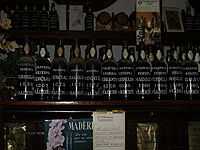
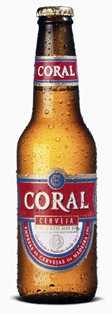
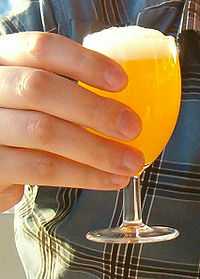
Music
Folklore music in Madeira is widespread and mainly uses local musical instruments such as the machete, rajao, brinquinho and cavaquinho, which are used in traditional folkloric dances like the bailinho da Madeira.
Emigrants from Madeira also influenced the creation of new musical instruments. In the 1880s, the ukulele was created, based on two small guitar-like instruments of Madeiran origin, the cavaquinho and the rajao. The ukulele was introduced to the Hawaiian Islands by Portuguese immigrants from Madeira and Cape Verde.[62] Three immigrants in particular, Madeiran cabinet makers Manuel Nunes, José do Espírito Santo, and Augusto Dias, are generally credited as the first ukulele makers.[63] Two weeks after they disembarked from the SS Ravenscrag in late August 1879, the Hawaiian Gazette reported that "Madeira Islanders recently arrived here, have been delighting the people with nightly street concerts."[64]
Gastronomy
Food
Fish
Because of the geographic situation of Madeira in the Atlantic Ocean, the island enjoys an abundance of fish of various kinds. The species that are consumed the most are Espada (Black scabbardfish), Blue Fin Tuna, White Marlin, Blue Marlin, Albacore, Bigeye Tuna, Wahoo, Spearfish, skipjack tuna and many others are found in the local dishes as they are found up and down the coast of Madeira. Espada is often served with banana. Bacalhau is also popular just like in Portugal.
Meat
There are many meat dishes on Madeira, one of the most popular being espetada.[65] Espetada is traditionally made of large chunks of beef rubbed in garlic, salt and bay leaf and marinated for 4 to 6 hours in Madeira wine, red wine vinegar and olive oil then skewered onto a bay laurel stick and left to grill over smouldering wood chips. These are so integral a part of traditional eating habits that a special iron stand is available with a T-shaped end, each branch of the "T" having a slot in the middle to hold a brochette (espete in Portuguese); a small plate is then placed underneath to collect the juices. The brochettes are very long and have a V-shaped blade in order to pierce the meat more easily. It is usually accompanied with the local bread called bolo do caco.
Other popular dishes in Madeira include açorda, feijoada, carne de vinha d'alhos.
Pastries
Traditional pastries in Madeira usually contain local ingredients, one of the most common being mel de cana, literally "sugarcane honey" (molasses). The traditional cake of Madeira is called Bolo de Mel, which translates as (Sugarcane) "Honey Cake" and according to custom, is never cut with a knife, but broken into pieces by hand. It is a rich and heavy cake. The cake commonly well known as "Madeira Cake" in England also finds its naming roots in the Island of Madeira.
Malasadas are a Madeiran creation which were taken around the world by emigrants to places such as Hawaii. In Madeira, Malasadas are mainly consumed during the Carnival of Madeira. Pastéis de nata, as in the rest of Portugal, are also very popular.
Other
Milho frito is a very popular dish in Madeira which is very similar to the Italian dish polenta. Açorda Madeirense is another popular local dish.
Beverages
Wine
Madeira is a fortified wine, produced in the Madeira Islands; varieties may be sweet or dry. It has a history dating back to the Age of Exploration when Madeira was a standard port of call for ships heading to the New World or East Indies. To prevent the wine from spoiling, neutral grape spirits were added. However, wine producers of Madeira discovered, when an unsold shipment of wine returned to the islands after a round trip, that the flavour of the wine had been transformed by exposure to heat and movement. Today, Madeira is noted for its unique winemaking process which involves heating the wine and deliberately exposing the wine to some levels of oxidation.[66] Most countries limit the use of the term Madeira to those wines that come from the Madeira Islands, to which the European Union grants Protected Designation of Origin (PDO) status.[67]
Beer
A local beer called Coral is produced by the Madeira Brewery, which dates from 1872. Other Portuguese beers are also popular on Madeira, but to a lesser extent.
Other Alcoholic drinks
Other alcoholic drinks are also popular in Madeira, such as the locally created Poncha, Niquita, Pé de Cabra, Aniz, as well as Portuguese drinks such as Macieira Brandy, Licor Beirão.
Soft Drinks
Laranjada is a type of carbonated soft drink with an orange flavour, its name being derived from the Portuguese word laranja ("orange"). Launched in 1872 it was the first soft drink to be produced in Portugal, and remains very popular to the present day. Brisa drinks, a brand name, are also very popular and come in a range of flavours.
Coffee
There is also a huge coffee culture in Madeira. Like in mainland Portugal, popular coffee-based drinks include Garoto, Galão, Bica, Café com Cheirinho, Mazagran, Chinesa and many more.
Madeira Gourmet Festival
To promote Madeiran gastronomy worldwide, every November the Madeira Gourmet Festival is held. The festival brings international chefs to the island, mixing their know-how with local young chefs and preparing new recipes using Madeiran traditional products, like Madeira wine, local fish and other products.
Sports
In Madeira a large number of sports are practised, both outdoors and indoors in the various facilities available throughout the island.
Football
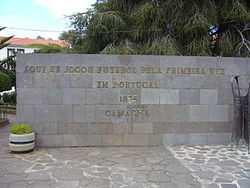
The first organised game of football took place in 1875 in Camacha, organised by the Madeira born Harry Hinton (it was the first organised football match anywhere in Portugal).
Madeira has two football teams in the Portuguese Liga (Portugal's top league): C.S. Marítimo and Nacional. There would have been three but União da Madeira were relegated from the top league in 1995 and have never been able to gain promotion back to the top league.
The Real Madrid and Portugal footballer Cristiano Ronaldo was born in Madeira and played for Nacional before going to Sporting Lisbon.[68]
C.S. Marítimo is considered the biggest club of Madeira and has enjoyed various campaigns in the UEFA Cup having recorded famous results against teams such as Juventus, Leeds and Rangers. Having finished 5th in the league in the 2009/2010 season, C.S. Marítimo qualified for the Europa League for the 2010/2011 season.[69]
C.S. Marítimo has nurtured great players such as Pepe, now at Real Madrid, Danny, now at Zenit, Jorge Costa, retired (F.C. Porto), Tarik Sektioui, who left F.C. Porto at the start of 2009/2010 league, Nuno Valente, retired, and Makukula, now at Manisaspor and many others.
In 2003–04 Nacional achieved fourth place in the Portuguese League, their best classification ever. They repeated it three years later and are the only Madeiran team to finish fourth place in the Portuguese League. Nacional is the only Madeiran team that reached the Europa League group stage (in the 2009-2010 season). Cristiano Ronaldo, one of the top football players ever, played in Nacional until he was 12-year old before moving to Sporting Lisbon. Nacional plays in the Madeira Stadium (Estádio da Madeira), considered by CNN in 2011, one of the eight more unusual stadiums in the world. Besides Cristiano Ronaldo, other known footballers played in Nacional like Paulo Assunção (played in F.C. Porto and Atletico Madrid), Ruben Micael (played in F.C. Porto and Zaragoza), Maicon (F.C. Porto), Diego Benaglio (Wolfsburg) and Felipe Lopes (Wolfsburg).
Outside the Portuguese top league, there are two other Maderian teams: U.D. Santana and A.D. Pontassolense. U.D. Santana was relegated from the Portuguese Second Division so it now competes in the Portuguese Third Division while A.D. Pontassolense plays in the Portuguese Second Division.
Basketball
In recent years, Madeira has had a considerable amount of success in professional basketball, with CAB Madeira having won numerous titles, especially their female team. CAB is often seen competing in European matches such as the FIBA EuroCup and former stars include Filipe da Silva and ex-Los Angeles Lakers player Ike Nwankwo.
Surfing

In 2001 the World Surfing Championships were held in Madeira at Surfspots including Paul do Mar, Ponta Pequena and Jardim do Mar (see Surfing in Madeira).
Handball
Madeira Andebol SAD, the island's only professional handball team is one of the most successful in the country.
Rugby
Rugby union is also played on the island to a minor degree.[70]
Running
The oldest Saint Silvester Road Race in Portugal and one of the oldest in Europe is held every December 28 and is called the Volta à cidade do Funchal and is made up of professional and amateur runners.
There is also the Madeira Island Ultra Trail which is an ultramarathon, that takes place once a year.
Walking and hiking

Madeira offers about 600 miles (966 kilometres) of walks, many alongside the levadas, some of the island's greatest attractions. The levadas provide stunning walks, some of which are quite challenging.[71] Canyoning has increased in popularity over the last few years with many companies offering canyoning tours.
Fishing
Due to the geographic situation of Madeira, the island enjoys an abundance of fish of various kinds. The species that can be caught are black scabbardfish, blue fin tuna, white marlin, blue marlin, albacore, bigeye tuna, wahoo, spearfish, skipjack tuna and many others are found up and down the coast of Madeira.
Dolphin (common dolphin, spotted dolphin, striped dolphin, bottlenose dolphin, short-finned pilot whale) and whale (sperm whale and fin whale) watching is also very popular.[72]
Other sports
While rally car racing (Rali Vinho da Madeira), karting and golf are other popular sports played on the island. The island lies in an ideal location for water sports such as fishing, sailing and diving due to its climate and location. Jogo do Pau, a Portuguese martial art, is still practised in the rural areas of the island but has declined since its peak in the early part of the 20th century.
Sister provinces
Madeira Island has one sister province which is also an island:
 – Jeju Province, South Korea
– Jeju Province, South Korea
Postage stamps
Portugal has issued postage stamps for Madeira during several periods, beginning in 1868.
Notable citizens


The following people were either born or have lived part of their lives in Madeira:
- António de Abreu, naval officer and navigator
- Nadia Almada, a winner of the British reality show Big Brother
- Menasseh Ben Israel, a notable Jewish Rabbi.
- Joe Berardo, Portuguese millionaire, and art collector
- Pedro Macedo Camacho, composer
- Charles I of Austria, deposed monarch, died in exile on Madeira in 1922
- Catarina Fagundes, Olympic athlete for windsurf
- Vânia Fernandes, Portuguese singer who represented Portugal in Eurovision 2008
- José Vicente de Freitas, military and politician
- Vasco da Gama Rodrigues, poet, born in Paul do Mar
- Teodósio Clemente de Gouveia, Cardinal of the Roman Catholic Church
- Herberto Hélder, poet
- Moisés Henriques, former Australian Under-19 Captain and current NSW Blues cricketer
- Alberto João Jardim, President of the Regional Government
- Luís Jardim, producer of music
- Paul Langerhans, German pathologist and biologist
- Fátima Lopes, fashion designer
- Jaime Ornelas Camacho, first and former President of the Regional Government
- Aires de Ornelas e Vasconcelos, former Archbishop of the former Portuguese colonial enclave Goa (in India)
- Sir Lloyd William Matthews, British naval officer, politician and abolitionist
- Dionísio Pestana, president of the Pestana Group
- Rigo 23, artist
- João Rodrigues, Olympic windsurfer
- Cristiano Ronaldo, Real Madrid, Portugal and former Manchester United football player
- John Santos, photographer
- Ana da Silva, founding member of the post-punk band The Raincoats
- Manoel Dias Soeyro or Menasseh Ben Israel (1604–1657), Sephardi Rabbi and publisher
- Artur de Sousa Pinga, former CS Marítimo and FC Porto football player
- Maximiano de Sousa (Max), popular singer, born in Funchal
- Virgílio Teixeira, actor
- José Travassos Valdez, 1st Count of Bonfim, governor in 1827–1828
See also
- History of Portugal
- Madeira Island Open, an annual European Tour golf tournament.
- Surfing in Madeira
- University of Madeira
References
- Notes
- ↑ http://www.ine.pt/scripts/flex_v10/Main.html
- ↑ Until 2002, the Portuguese escudo was used in financial transactions, and until 1910 the Portuguese real was the currency used by the monarchy of Portugal.
- ↑ 3.0 3.1 "GDP per inhabitant in 2008". Eurostat. Retrieved 2011-03-29.
- ↑ 4.0 4.1 4.2 INE, ed. (2010), Censos 2011 - Resultadas Preliminares [2011 Census - Preliminary Results] (in Portuguese), Lisbon, Portugal: Instituto Nacional de Estatística, retrieved 1 July 2011
- ↑ IGP, ed. (2010), Carta Administrativa Oficial de Portugal (in Portuguese), Lisbon, Portugal: Instituto Geográfico Português, retrieved 1 July 2011
- ↑ "EUROPA - Glossary - Outermost regions". Europa.eu. 2008-07-17. Retrieved 2010-07-30.
- ↑ "Hotelaria da Madeira suaviza quebras em 2010 apesar de impacto devastador dos temporais". presstur.com. 08-02-2001. Retrieved 2011-09-16.
- ↑
- ↑ "A Guinness World Record Fireworks Show – Madeira Island, 2006-2007 New Year Eve at Wayfaring Travel Guide". Wayfaring.info. Retrieved 2011-09-16.
- ↑ "Madeira welcomes most cruisers". The Portugal News. Retrieved 2013-03-12.
- ↑ "Regional GDP per capita in the EU in 2010: eight capital regions in the ten first places" (PDF). Eurostat. March 21, 2013. Retrieved 2011-06-23.
- ↑ Nicholas Cayetano de Bettencourt Pitta, 1812, p.11-17
- ↑ Fernández-Armesto, Felipe (2004). "Machim (supp. fl. 14th cent.)". Oxford Dictionary of National Biography. Oxford: Oxford University Press. doi:10.1093/ref:odnb/17535. Retrieved 2009-09-02.
- ↑ Nicholas Cayetano de Bettencourt Pitta, 1812, p.20
- ↑ The discoveries of Porto Santo and Madeira were first described by Gomes Eanes de Zurara in Chronica da Descoberta e Conquista da Guiné. (Eng. version by Edgar Prestage in 2 vols. issued by the Hakluyt Society, London, 1896–1899: The Chronicle of Discovery and Conquest of Guinea.) Arkan Simaan relates these discoveries in French in his novel based on Azurara's Chronicle: L'Écuyer d'Henri le Navigateur, published by Éditions l'Harmattan, Paris.
- ↑ Ponting, Clive (2000) [2000]. World history: a new perspective. London: Chatto & Windus. p. 482. ISBN 0-7011-6834-X.
- ↑ Godinho, V. M. Os Descobrimentos e a Economia Mundial, Arcádia, 1965, Vol 1 and 2, Lisboa
- ↑ Fernando Augusto da Silva & Carlos Azevedo de Menezes, "Porto Santo", Elucidário Madeirense, vol. 3 (O-Z), Funchal, DRAC, p. 124.
- ↑ "Christian Slaves, Muslim Masters: White Slavery in the Mediterranean, the Barbary Coast and Italy, 1500–1800". Robert Davis (2004). p.7. ISBN 1-4039-4551-9.
- ↑ "The Map Room: Africa: Madeira". British Empire. Retrieved 2010-07-30.
- ↑ "Who was in Madeira at the time of the second British occupation". King's College London. Retrieved 2012-04-29.
- ↑ "uboat.net". uboat.net. 2010-11-13. Retrieved 2010-11-13.
- ↑ "uboat.net". uboat.net. 2010-11-13. Retrieved 2010-11-13.
- ↑ "uboat.net". uboat.net. 2010-11-13. Retrieved 2010-11-13.
- ↑ "www.atlantic-cable.com". uboat.net. 2010-11-13. Retrieved 2010-11-13.
- ↑ The New York Times, Nov. 6, 1921 (accessed 4 May 2009)
- ↑ "Madeira Islands Tourism". Madeiraislands.travel. Retrieved 2010-07-30.
- ↑ Ribeiro et al., 1996
- ↑ Kullberg & Kullberg, 2000
- ↑ Geldemacher et al., 2000
- ↑ Ribeiro, 2001
- ↑ 32.0 32.1 "Madeira". Global Volcanism Program, Smithsonian Institution. http://www.volcano.si.edu/world/volcano.cfm?vnum=1802-12-.
- ↑ "MadeiraHelp.com". MadeiraHelp.com. 1999-02-22. Retrieved 2010-07-30.
- ↑ Robert White, 1851, p.4
- ↑ "World Map of Köppen−Geiger Climate Classification".
- ↑ "Weather Information for Funchal". June 2011. Retrieved 2011-03-29.
- ↑ "Funchal, Madeira Climate, Temperature, Average Weather History, Rainfall/Precipitation, Sunshine".
- ↑ Riebeek, Holli. "Fires in Madeira, Portugal". Earth Observatory. NASA Goddard Space Flight Center. Retrieved 8 September 2013.
- ↑ Sapa-DPA (16 August 2010). "Wildfires ravage Portuguese nature parks". IOL News. Retrieved 8 September 2013. "Fires that had raged there in the recent days had devastated 95 percent of Funchal Ecological Park, destroying a decade of efforts to replant indigenous species in the area measuring 1 000 hectares, the daily Publico quoted environmentalists as saying."
- ↑ "Fires ravage Madeira islands and mainland Portugal". Reuters. 19 July 2012. Retrieved 8 September 2013. "Wildfires forced the evacuation of dozens of villagers from their homes on the Portuguese archipelago of Madeira on Thursday and authorities sent teams from the mainland to help overwhelmed local firefighters. Cash-strapped Portugal, which is under an EU/IMF bailout, had suffered from a severe drought this year before being hit by scorching summer temperatures of up to 40 degrees Celsius this week, triggering intense forest blazes on the mainland too."
- ↑ Scott, Michon. "Madeira Wildfires". Earth Observatory. NASA Goddard Space Flight Center. Retrieved 8 September 2013.
- ↑ Miller, Shari (20 July 2012). "Holiday resorts under threat as towering walls of flame ravage Madeira islands". Daily Mail. Retrieved 8 September 2013. "Dozens of people have been forced to evacuate their homes as wildfires sweep across the Portuguese islands of Madeira. Firefighters have been battling the flames, caused by scorching summer temperatures of up to 40C (104F), since Wednesday. Efforts have also been hampered to contain the erupting flames because of high winds."
- ↑ "Portugal's Madeira hit by forest fires". BBC News. 20 July 2012. Retrieved 8 September 2013. "On Wednesday, TV images showed flames several storeys high right on the edge of Madeira's main town, Funchal. The area is now out of danger. Two houses were destroyed and at least 25 more damaged in the town, according to officials quoted by the Associated Press. At least 75 firefighters have been despatched from the Portuguese mainland to help the overstretched fire services."
- ↑ Porter, Tom (17 August 2013). "Hospital Evacuated as Fire Rages on Madeira". IBTimes UK. Retrieved 8 September 2013. "Around 150 patients were evacuated from the Hospital of Quince over fears of smoke inhalation and taken to the central hospital and a military base, as fires burned on the hills above the city last night and a blackout plunged it into darkness."
- ↑ "Wildfire inferno forces hospital and homes to be evacuated on Portuguese island Madeira". euronews. 17 August 2013. Retrieved 8 September 2013. "The fire hit the Monte suburb of the capital Funchal. It had been burning out of control for the 24 hours and worsened overnight on Friday, officials said. Authorities said it was too early to say how many homes were destroyed by the fire."
- ↑ Fernandes, F. (2011). "Jasminum azoricum". IUCN Red List of Threatened Species. Version 2012.2. Retrieved 8 January 2013.
- ↑ Map of municipalities at FreguesiasDePortugas l.com
- ↑ Statistics include Savage Islands, which are administered by the parish of Sé
- ↑ Statistics include the mainland parish of Santa Cruz and the islands of the Desertas
- ↑ Statistics represent island population; Porto Santo is the second largest island in the archipelago of Madeira
- ↑ "Alberto Vieira, ''O Infante e a Madeira: dúvidas e certezas, Centro Estudos História Atlântico". Ceha-madeira.net. Retrieved 2010-07-30.
- ↑ "The relatively high proportion of African lineage clusters L1–L3, U6, and M1 in Madeira (18.7%) and only 5.1% in the Açores agrees well with previous estimates of African admixture based on HLA and STR markers (Spínola et al. 2002; Fernandes et al. 2003)". Mitochondrial portraits of the Madeira and Açores archipelagos witness different genetic pools of its settlers, Brehm et al. 2003
- ↑ Y-chromosome lineages from Portugal, Madeira and Açores record elements of Sephardim and Berber ancestry, Goncalves et al. 2005
- ↑ "Portuguese emigration from Madeira to British Guiana"
- ↑ "BBC – Jersey Voices"
- ↑ "About IBC: The International Business Centre of Madeira"
- ↑ "Statistics from DRE of Madeira tourism (2008)" (PDF). Retrieved 2010-07-30.
- ↑ "Denguekuume leviää Madeiralla (‘Dengue Fever Spreads In Madeira’)". YLE.fi. 2012-10-10. Retrieved 2012-10-20.
- ↑ "Dengue Fever in Madeira, Portugal". WHO. 2012-10-17. Retrieved 2012-10-20.
- ↑ "Dengue outbreak in Madeira controlled". Retrieved 2013-04-11.
- ↑ "SEFSTAT – Portal de Estatística". Sefstat.sef.pt. Retrieved 2010-07-30.
- ↑ Nidel, Richard (2004). World Music: The Basics. Routledge. p. 312. ISBN 978-0-415-96800-3.
- ↑ Roberts, Helen (1926). Ancient Hawaiian Music. Bernice P. Bishop Museum. pp. 9–10.
- ↑ King, John (2000). "Prolegomena to a History of the ‘Ukelele". Ukulele Guild of Hawai'i. Retrieved 2008-06-11.
- ↑ "Madeira Espetada". theworldwidegourmet.com. Retrieved 2010-08-30.
- ↑ T. Stevenson "The Sotheby's Wine Encyclopedia" pg 340–341 Dorling Kindersley 2005 ISBN 0-7566-1324-8
- ↑ "Labelling of wine and certain other wine sector products". Europa.eu. Retrieved 2013-03-12.
- ↑ "Cristiano Ronaldo". Diariodigital.sapo.pt. Retrieved 2010-07-30.
- ↑ "Cristiano Ronaldo". Portugoal.net. 2010-05-10. Retrieved 2010-07-30.
- ↑ "Rugby Madeira". Rugbymadeira.blogspot.com. 2010-05-29. Retrieved 2010-07-30.
- ↑ "Levadas of Madeira". Walkingmadeira.com. Retrieved 2010-07-30.
- ↑ "Madeira whale and Dolphin watching". www.madeirawindbirds.com. 2010-08-30. Retrieved 2010-12-10.
- Sources
- Pitta, Nicholas Cayetano de Bettencourt (1812). Account of the Island of Madeira. London, England: C.Stewart Printer.
External links
| Find more about Madeira at Wikipedia's sister projects | |
| |
Definitions and translations from Wiktionary |
| |
Media from Commons |
| |
Quotations from Wikiquote |
| |
Source texts from Wikisource |
| |
Textbooks from Wikibooks |
| |
Travel guide from Wikivoyage |
| |
Learning resources from Wikiversity |
| ||||||||||||||||||||||||||||||||||||||||||||||||||||||||||||||||||||||||||||||||||||||||||||||||||||
| ||||||||||||||||||||||||||||||||||||||||||||||||||||||||||||||||||||||||||||||||||||||||||||||||||||||||||||||||||||||||||||


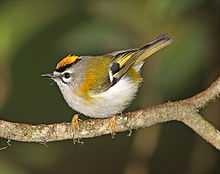
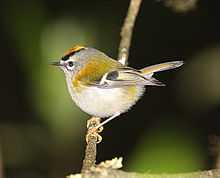




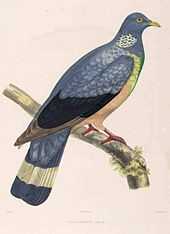







.jpg)
.jpg)
_-_May_2007.jpg)
